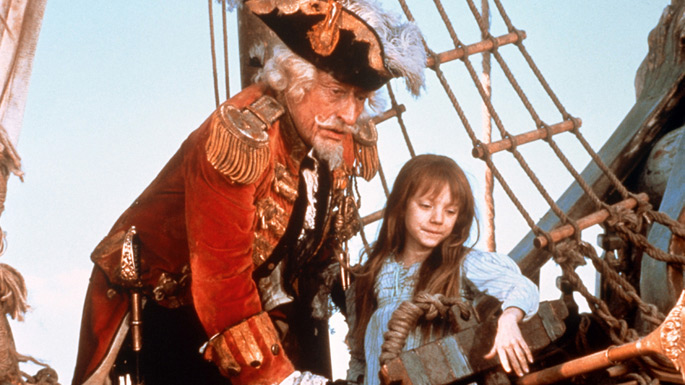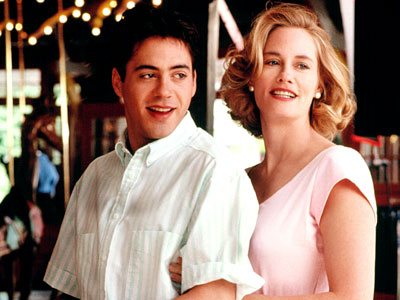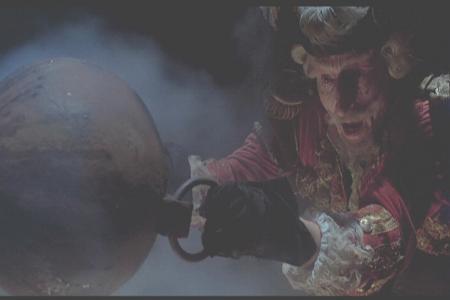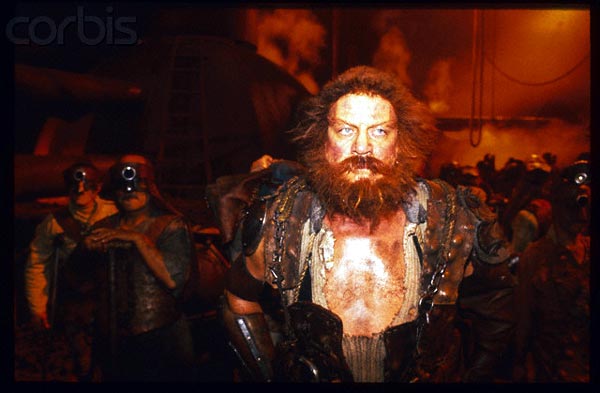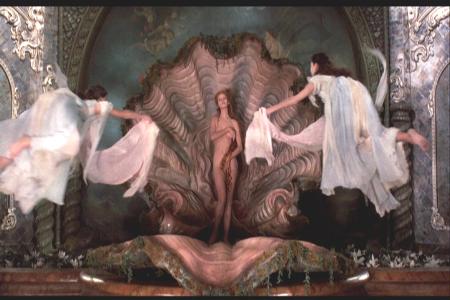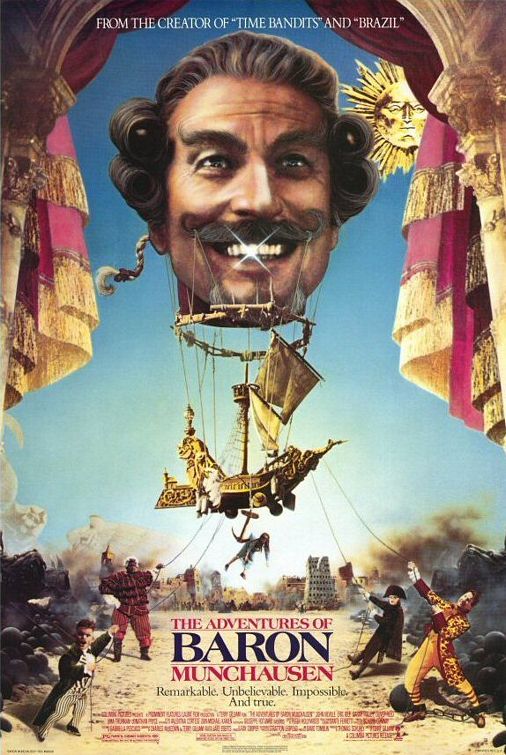From the March 17, 1989 Chicago Reader. At least in memory, The Adventures of Baron Munchausen continues to remind me of Italo Calvino’s Cosmicomics. — J.R.
THE ADVENTURES OF BARON MUNCHAUSEN
*** (A must-see)
Directed by Terry Gilliam
Written by Charles McKeown and Gilliam
With John Neville, Eric Idle, Sarah Polley, Robin Williams, Oliver Reed, Uma Thurman, Jonathan Pryce, Winston Dennis, and Valentina Cortese.
CHANCES ARE
** (Worth seeing)
Directed by Emile Ardolino
Written by Perry Howze and Randy Howze
With Cybill Shepherd, Robert Downey Jr., Ryan O’Neal, Mary Stuart Masterson, and Christopher McDonald.
I can no longer recall whether any of Rudolf Erich Raspe’s late-18th-century best-seller The Adventures of Baron Munchhausen was read to me as a child. But there’s no question that these tall tales of comic extravagance — based on stories told by one Karl Friedrich Hieronymous (the Baron von Munchhausen) to his German poker buddies during the same period — have held a special place in children’s literature ever since. Reportedly about a dozen and a half film versions of the stories precede Terry Gilliam’s current entry, although I presume that most of these are silent and/or European, because I can find only one listed in Leonard Maltin’s extensive TV Movies (The Fabulous Baron Munchausen by Karel Zeman).
Calling Gilliam’s The Adventures of Baron Munchausen noncontemporary almost sounds like an understatement. Set in the late 18th century, when the original stories were written, its main influences and counterparts — the silent fantasy films of Georges Méliès and the comic strip “Little Nemo in Slumberland” by Winsor McCay — are found a little over a century later, i.e., 80 or 90 years ago. Even if one views time in terms of decades rather than centuries, Terry Gilliam is anything but an 80s personality; his particular brand of antiauthoritarian fantasy and adolescent humor belongs much more to the 50s (Mad comics and The 5,000 Fingers of Dr. T.) and the counterculture 60s than to anything in the last 20 years. Even his controversial reputation as an auteurist overreacher, which seems to be responsible for much of his recent mixed press, finds few genuine contemporary parallels, and critics who call him self-indulgent are missing the point that excess is essential to his vision (as it is to such legendary — albeit very different — overreachers as Erich von Stroheim and John Cassavetes).
Part of what’s disconcerting about all of Gilliam’s movies, in fact, is the combination of metaphysical aspirations with small-scale slapstick, almost as if he were combining the contrary impulses of two other American directors who have spent most of their careers in England, Stanley Kubrick and Richard Lester. His Baron Munchausen, to take one example, is made up and often even framed to suggest the figure of Don Quixote, but it’s not a reference that carries much weight because he’s a comic-book Quixote without a Sancho Panza (unless the little girl who accompanies him on his adventures dimly qualifies). The film offers three separate views of hell — a war-torn European city, a red-hot (and anachronistically conceived) nuclear missile plant straight out of Hellzapoppin within the crater of Mount Etna, and the inside of the belly of a gigantic sea monster — but no single discernible thread allows us to link up all three. The film is also preoccupied with the aging baron’s proximity to death, but here again there’s a tendency to contradict or at least complicate this serious element with a certain nose-thumbing irreverence. In short, what Gilliam’s Kubrickian right hand lays on like a trowel, his Lesteroid left hand usually scatters, leaving the viewer to pick up all the pieces.
Thanks to such contradictions, the movie’s overall movement often seems closer to that of a boiling cauldron than to any logical progression. But this wild spectacle has an energy, a wealth of invention, and an intensity that for my money still puts most of the streamlined romps of George Lucas and Steven Spielberg to shame; and it never gropes after the formulaic moves that make even a delight like Who Framed Roger Rabbit seem relatively hidebound and lacking in danger. A fantasy in which literally anything can happen at any moment runs the serious risk of flying apart without a center; and there is hardly a moment in this movie’s 126 minutes when Gilliam isn’t taking that risk — both eyes open and full speed ahead.
He even doubles the odds against his safety by insisting from the beginning on a certain amount of self-acknowledged artifice in both his story frame and his visual design. In an unnamed, besieged European city being torn apart by cannon blasts from Turks, a very Méliès-like stage production of The Adventures of Baron Munchausen (with charmingly and precariously floating and sliding backdrops) is being performed in a half-destroyed theater, when the real baron (John Neville) suddenly turns up, protesting the way he’s being represented and claiming to the skeptical crowd, “Only I can end this war . . . because I began it.” Promising to “reveal the true cause of the war,” he launches into an onstage monologue that leads straight into a flashback. But to confuse matters, his servants in the flashback — including Berthold (Eric Idle), who can run faster than a bullet, and Albrecht (Winston Dennis), who can carry all the sultan’s treasures on his back — are played by the same actors impersonating these characters in the stage production.
A comparable kind of doubling of artifice occurs after the flashback ends and the real baron sails away on a balloon made out of bloomers (with Sally, the real daughter of the false baron, as a stowaway) to recover four lost servants. His first stop is on the moon, where the shifting and floating scenery explicitly recalls the stage machinery in the theater; and throughout his other adventures, the notion of what is “real” fantasy and what is bogus — and whether the baron is lying or telling the truth — becomes purposefully and intricately confused. It’s on the moon, in fact, that the picture really comes to life, entering a free-form Lewis Carroll universe ruled by the giant disembodied heads of the Moon King (an uncredited and very funny Robin Williams, with an Italian accent) and Queen (Valentina Cortese) and their randy independent bodies, leading to metaphysical (and physical) divisions that are as skewed as the conflicts in Gilliam’s directorial personality. The film’s most beautiful shot is the mysterious moon landing, which proceeds like a series of overlapping optical illusions — stars become watery reflections of stars, which become in turn churning sprays of moon dust as the baron’s vessel gradually comes to rest — and the displacements formally and perceptually reproduce the overall Chinese-box construction of the plot.
Some of the movie’s confusions, then, are conceptual as well as integral. Others are no doubt due to scenes that were eliminated from the script when the film’s budget began to escalate and perhaps still other scenes that Gilliam may have had to remove from the rough cut (although he hasn’t made any disavowal of the release version). Even more problems may be ascribable to flaws in Gilliam’s conception from the beginning. But because Gilliam, like Stroheim, has imposed his personality so forcefully on what is there, our inclination is to assign all the blame to him for what went wrong as well as all the credit for what went right. Gilliam has, after all, described this as the third part of a trilogy after Time Bandits and Brazil, dealing with old age after treating childhood and adulthood in the earlier parts; from this point of view, it seems possible that some of the confusion in the movie may be a deliberate reflection of the confusion between memory and imagination that crops up in old codgers like Munchausen. (I must confess, however, that Brazil strikes me, for all its virtues, as a singularly sophomoric view of adulthood.)
The problem is worth dwelling on because some of the film’s confusions are delightful while others are merely distracting, and still others exist in an ambiguous zone in between. One of the movie’s best scenes occurs in the ornate 18th-century drawing room of Vulcan (Oliver Reed), who presides over the missile plant in the volcano crater — a seemingly large drawing room that Gilliam somehow contrives to make claustrophobic thanks to a manipulation of scale, which he utilizes effectively throughout much of the film. In this case, the confusion seems to derive from several sources, including the abnormally small teacups that the baron and Sally are drinking from, as well as the way the overall space seems at different times to be both open and closed. At one point, we glimpse a cow standing in a corner of the room and beyond the cow an outdoor pastoral setting that recedes far into the distance — a bizarre and unexplained detail, completely out of kilter with our overall spatial orientation (the scene is supposedly set far underground, near the center of the earth), and a good example of Gilliam’s capacity to give some of his settings a dreamlike illogicality. (Comparable games with space occur in the sultan’s treasure room, on the moon, and in the sea monster’s belly, among other places.)
In the same drawing room, we witness an enormous seashell emerge from a sizable body of water and open up to reveal the lovely figure of Vulcan’s wife, Venus (Uma Thurman, who also appears as Cecile de Volanges in Dangerous Liaisons), accompanied by two female angels who proceed to drape her in white fabric. She invites the baron to dance with her, and they wind up waltzing in midair in an adjacent “ballroom,” moving up into the clouds from a cavernous space below surrounded by fountains and grottoes. Much later in the film, back in the besieged European city, the same character reappears, without explanation, as one of the actors in the theater group.
“A string of pearls without a string” — Sergei Eisenstein’s description of the writing of Russian formalist Viktor Shklovsky — applies pretty well to most of Gilliam’s efforts in Baron Munchausen, although it must be added that some of these pearls prove to be fake as well as genuine. The superficial characterization of the main villain, Horatio Jackson (Jonathan Pryce, the hero in Brazil), as a “man of reason” who both licenses the theater and conducts the war in progress — an all-around bad guy — seems especially puerile. But given Gilliam’s unusual talent for peripheral detail (which he shares with Mad comics from the 50s), this is a movie in which there’s literally as well as figuratively more than meets the eye, and I look forward to seeing it again; I also suspect that it’s a work that will grow in stature in the years to come.
The word is out: The Adventures of Baron Munchausen isn’t as good as such fantasies as the 1940 The Thief of Bagdad, The Wizard of Oz, or Gilliam’s own previous Time Bandits and Brazil. In point of fact, Emile Ardolino’s Chances Are, another fantasy-comedy that was released the same day, isn’t as good as any of those classics either, but nobody seems to be complaining.
Personally, I find Gilliam’s movie a lot more interesting than Ardolino’s, but it sounds like most critics, distributors, and exhibitors think otherwise. After all, Chances Are, a moderately budgeted picture, opened at almost a dozen venues in the Chicago area, including some of the biggest and best-equipped theaters. Baron Munchausen, which cost about $46 million, opened on only one screen — not one of the largest, and a rather dirty one at that — at the Fine Arts, where the projection and sound were far from ideal. (Fortunately, the film has since moved to a larger and cleaner screen at the same theater, and will eventually open more widely.)
The irony is that Gilliam’s wide-eyed and imaginative adventure would seem to have a much broader appeal; Ardolino’s, by contrast, mainly offers a series of titillating laughs, many of them based on incest fantasies. Chances Are — which has an intricate plot that is nonetheless pretty easy to follow — is the latest entry in the recent cross-generational body-exchange cycle, and its plot revolves around a stock notion of heaven that is also currently quite popular. Baron Munchausen — which has a relatively simple plot that is at times difficult to follow — makes no such appeal to familiarity, and it is one of the only recent movie fantasies (apart from the forthcoming Parents) that is more concerned with hell than with heaven.
To its credit, Chances Are has very likable performances by Cybill Shepherd and Ryan O’Neal, both of whom seem to improve with age in the depth and range of their personalities, as they move beyond their ingenue origins (although from this standpoint, their costar Robert Downey Jr. still has a long way to go). I can’t really say too much about this movie because its principal pleasure derives from its labyrinthine plot twists, which can’t be described without giving them away. But I can make the point that any movie that depends this much on plot alone is likely to wind up being as disposable as Kleenex, and I suspect that a few years from now, when The Adventures of Baron Munchausen is being revived as a flawed classic, Chances Are won’t be much more than a dim memory.
Chances Are may have a cleverly constructed plot (written by sisters Perry and Randy Howze, who also scripted Maid to Order and Mystic Pizza), but artistically it’s much more of a mess than Gilliam’s film. The overlit cinematography by William A. Fraker, which suggests linens that have been soaked in too much bleach, is consistently tacky and ugly. The film opens in 1963, at the wedding of the hero (Christopher McDonald) and heroine (Cybill Shepherd) in Washington, D.C., then cuts to their first wedding anniversary, when she announces her pregnancy. Shortly after that he dies in a car accident, goes to heaven (where he’s processed for reincarnation, although an angel forgets to blip out his memory), and is then reborn in Cleveland. The remainder of the story occurs 22 years later, when the baby, now grown up (Robert Downey Jr.), comes to Washington after graduating from Yale. But the movie does almost nothing to give a sense of period — not even the title song, whose lyrics have no discernible relation to the plot, belongs to the early 60s — and its contrived handling of coincidence and destiny has the congealed quality of a comedy sitcom, which appears to be more or less what the audience expects from it. (For the record, Ardolino was more adept at handling 1963 in his only previous feature, Dirty Dancing.) Despite the pleasant presences of Shepherd and O’Neal (as well as Mary Stuart Masterson, who plays Shepherd’s daughter Miranda), the upscale characters are basically stock figures; there’s even a cameo by bandleader Lester Lanin, who appears at a fancy Smithsonian Institution party — the embodiment of nostalgic squareness, which the movie cheerfully revels in.
The movie’s heaven is 80s standard issue: quaintly bureaucratic, with orderly lines of people (all of them white, of course, and apparently upscale) milling through the cloudy mist at knee-level, with the notion of reincarnation as usual sitting rather oddly with cliched notions of a Christian afterlife. There’s even a lovable angel who later comes to earth à la It’s a Wonderful Life to make sure things work out.
Chances Are is an agreeable enough movie if you have the low expectations a lot of people seem to bring to movies nowadays. Ringing a few bright changes on the cross-generational body-exchange theme — complete with a familiar contrivance that might be labeled “deus ex amnesia,” and that further permits an audience to have its titillating cake and eat it too (incest is OK as long as you’ve got amnesia) — it certainly holds one’s interest, and manages with its highly symmetrical plot to give a kind of narrative satisfaction that is superior to that found in most of the other cross-generational body-exchange comedies.
I might even go so far as to boldly assert that Chances Are is the best cross-generational body-exchange comedy to date. The Adventures of Baron Munchausen, by contrast, isn’t even the best Baron Munchhausen movie. (I’ve only seen one other, but this happens to have been Karel Zeman’s extraordinary 1961 Czech version, combining animation with live action — a masterpiece that I caught quite by chance on European TV last fall.) It also isn’t the best Terry Gilliam movie, and is certainly inferior as story telling to The Wizard of Oz and Michael Powell’s The Thief of Bagdad.
But let’s try to keep a little bit of proportion about this. Chances Are is charming and watchable but irredeemably inconsequential. The Adventures of Baron Munchausen is a failed visionary masterpiece with ambitions (and some achievements) so large that it is worth any number of successful pieces of treacle. I also had a better time watching it.

